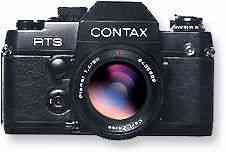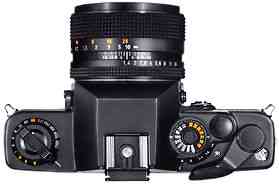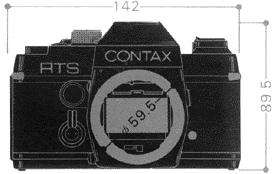Contax RTS (Real Time System)1975-1982
I really liked this camera. These are not my pics, but borrowed from the web. The Camera was purchased used with the normal 55mm f1.4, a Yashica 200mm f4, and the Yashica 38-90mm f3.8 zoom. I still have the two Yashica lenes. I've had many 30-30 second AE exposures with great accuracy with this camera.
I purchased a Yashica FR Body and Yashica Autowinder to compliment this camera.
| The original CONTAX RTS was introduced in 1975. The highly advanced electronic SLR system camera developed by mutual cooperation of Carl Zeiss, West Germany, and Yashica, Japan. It offers the advantage of one of the most sophisticated fully automatic through-the-lens exposure control available during the late seventies. |  |
| The optical system - centered around the famed Zeiss optics was another very attractive reason for one to select Contax SLR system. The Bayonet Mount also a product of mutual cooperation between Carl Zeiss and Yashica affords perfect coordination of the optical, mechanical and electronic systems. |  |
| Zeiss T * Lenses , the soul of the Contax system. To take advantage of one of the most respectable optical manufacturer in the industry, a new Bayonet Mount - a product of mutual cooperation between Carl Zeiss and Yashica - offer a perfect coordination between some finest and most sophisticated optical, mechanical and electronic engineering fields. An the RTS system has a full range of precision-plus Zeiss T* Lenses designed especially for the Contax RTS. The early optics were using a AE mount but it was replaced with a newer MM mount that can take advantage of the multi-AE features found in the newer breed of Contax SLR cameras. Lenses made in Germany are considered by some to be better, but most of the Zeiss lenses - except some exotic and rare items are mostly produced in Japan now. |  |
|
Viewfinder Display: 16-dot LED shutter speed display shows calibrated and in-between speeds; Green shutter speed pointer overlaps 'A' setting on Auto and indicates shutter control dial setting on Manual Aperture display shows maximum aperture of the lens in use on the extreme right and f-stop in use in green figure; Exposure compensation tab appears when the exposure compensation pointer is set at any position other than 'X1". |
 |
|
|
 |
Lens Mount: Contax/Yashica Mount (three-claw bayonet mount) developed by mutual co-operation of Carl Zeiss, West Germany, and Yashica, Japan
Standard Lens: PLANAR T
*
50 mm f/1.4 composed of 7 elements in 6 groups, interchangeable with a wide range of Carl Zeiss lenses
Shutter: Horizontal travelled silk fabric electronic focal plane shutter of a unique design (primary and secondary shutter curtains uncap to provide starting from the identical position. Electronic timing on both Auto and Manual, shutter speeds continuously variable from LT (4 sec ) to 1/2000 sec on Auto; 14 click stop settings from 4 to 1/2000 sec and 'B' on Manual and 'X' sync terminal
Shutter Release: Feather-touch magnetic release Release socket for cable switch and for off-camera electronic remote control
Exposure Control: Through-the-lens automatic exposure control with SPD sensor above the viewfinder eyepiece taking center-weighted light reading; Fully automatic exposure through lens aperture pre-selection (exposure readout on manual operation); LED shutter speed display
in viewfinder.
EV range: From EV -1 to 19 (f 1. 4 at ASA 100);
Film Speed range: ASA range from 12 to 3200
ï ï
Operates on 6V silver oxide or alkaline battery (Eveready 544, Ucar 544, Mallory PX28, Alkaline Eveready 537 or equivalent)
Exposure Compensation: Provision for exposure compensation with scale calibrated from x4 to x9 ; in between settings feasible.
Viewfinder: Through-the-lens reflex viewfinder shows up to 92% of the actual picture area with magnification ratio 0 87x ï Pentaprism is silver coated; Reflection mirror multi-layer coated to ensure maximum brightness of the viewfinder field.
Focusing screen: Focusing screen interchangeable from the lens mount side. Seven types are available Standard screen used is matte field with microprism spot.
Film Advance: Film advance lever advances film through a single 140 degree stroke or several short ratchet action; Exposure counter resets automatically to start position when the back cover is opened
Film Rewind: Film rewind crank-handle with unique clutch action; White index line on top of the knob rotates to indicate proper film advance
Camera Back : Back cover opens when the film rewind knob is pulled all the way out ecamera; Back interchangeable with optional RTS Data Back or 250 Bulk Film Back (for use with motor drive unit)
Other Features:
ï
Multiple exposure through depression of the film rewind release button
ï
Mirror lock-up lever
ï
LED battery checker display
ï
Depth-of-field preview button
ï
Direct X contact shoe with anti-shock provision
ï
Motor drive coupling terminal and film advance coupler
ï
Power: Operates on 6V silver oxide or alkaline battery (Eveready 544 or
equivalent)
ï
Size: 142mm x 89.5mm x 50mm
ï
Weight: approx 700 grams (body only)
